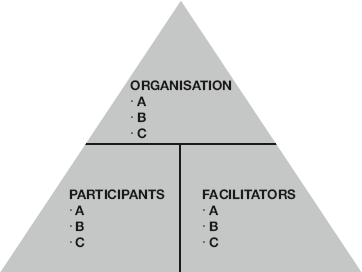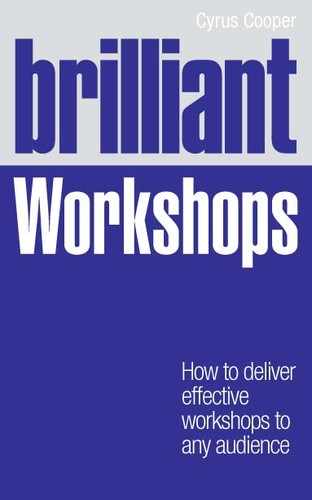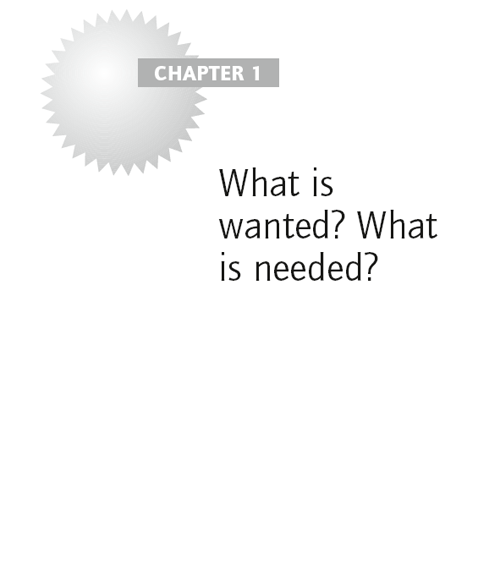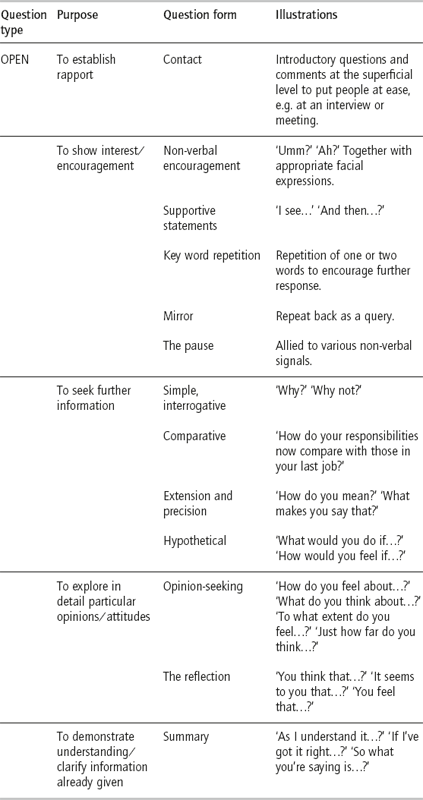You knew this day was coming. You need to be ready and use the five Ps:
- Proper
- Planning
- Prevents
- Poor
- Performance.
This chapter will focus on truly understanding the client. A request has come your way and you now have to become a mind-reader to decipher the training requirement. You will ask brilliant questions to get the answers you want. You will engage effectively and realise that you will need to get the workshop right to reach the right result. It will focus on want vs need and how you can begin to take control of the situation. Question whether training is the right solution for them.
You can tell whether a man is clever by his answers. Naguib Mahfouz |
Defining the need
The first contact
You may receive many different requests for ‘training’. It can range from a quick phone call to a long consultation meeting. I remember coming into my office to find a Post-it note requesting management training for a team. There were four small lines of text, including the date – three days’ time. Talk about a challenge. A great starting point is to understand the difference between a trainer and a facilitator. Clients will often use both terms without differentiation. Although there are many similarities, it is the differences that you should be aware of.
More importantly, the requester (or client as I will refer to them throughout) needs to know the difference between training and facilitation. This will unpack the required role for all parties.

Trainer
A trainer is ‘someone who trains people’.
Facilitator
A facilitator is there to ‘make (an action or process) easy or easier’.
(Oxford English Dictionary)
Facilitation
The facilitator’s role is much more about opening things up for discussion in a stimulating way, getting ideas into the open and helping the group to listen to each other, further its knowledge and thus make informed decisions. Cameron, 2001 |
A trainer starts from their own knowledge – whereas the facilitator starts from the group’s knowledge. Ideally, they should be process leaders only – they have no decision-making authority and nor should they contribute to the substance of the discussion. To be effective as a facilitator, the role should, ideally, be a neutral one. There may be no right answer, but the skill is in guiding the group to their preferred outcome.
Often, managers ‘facilitate’ workshops within their team but cannot remain truly neutral as the outcome will affect them in some way. This can find them leading the conversation, consciously or sub-consciously, to a preferred outcome. A facilitator’s role can be compared to that of a football referee. It is often said that the best referees are the ones who have rarely been heard and have allowed the game to flow. A facilitator can be successful just by being an enabler. A facilitator does not have to be heard the most or be seen the most to be successful.
The majority of facilitators are subject knowledge specialists who have the skills to transfer that knowledge through a range of activities that are best suited to the learners. They will tend to have an interactive style, mingling through the participants, having some one-on-one discussions along the way and seeing themselves as part of that group.
Training
Training is more about directing what needs to be done. There is little room for manoeuvre or discussion. Trainers tell participants how it should be, what the ideal is and why they need to do it. They want participants to know the right answer. They may not get buy-in; they may not care, because following a particular process may have to happen for the team or organisation to succeed. For example, if an organisation wants to roll out a new appraisal system to hundreds or thousands of people, a trainer who understands the process, time-cycles and forms to be used will be suitable, as this is what every member of staff must do. There will be no alternative option.
Working in the Civil Service, part of my role was to do just that and it can become repetitive. However, it can also build confidence in the subject area, and by allowing no room for alternatives you can clearly and strongly set the tone and parameters for the expectations. A trainer will tend to deliver from the front of the room and will do most of the talking. There are times to train and times to facilitate. Knowing when to do this will ensure that your style matches the situation.
I cannot stand being taught – but I enjoy learning. Sir Winston Churchill |
The initial request
When you receive a request for training, you must never assume the client really knows what they truly want or need. This is where your questioning skills will be vital. Do not be afraid to ask many questions. For the workshop to be the best it can be for the client you need to truly understand as much as you can about what is required. Ask the person who has made the initial request if they are affected by the outcome. They may just be a messenger and may not be able to answer your questions accurately.
Understanding the need is one of the most important conversations you will have with the client. Invariably, experience tells me that if the training does not ‘hit the spot’ it is because the brief was not fully explained or understood. This is why we need to get as much information as possible and it is up to us to get clarity. If it is your chosen/current career, for credibility you need to be seen as the specialist, as there may be a lot riding on the outcome. If the client cannot articulate what success looks like, for example, then you should work with them to unpack this, not go away and ‘have a go’.
If, for example, you are facilitating a teambuilding workshop, why does the team require teambuilding? Are there sensitivities? Does X get on with Y? Is teambuilding just a title to cover up other issues? Is it a performance issue that sits better by calling it teambuilding? This last point is a common ‘misunderstanding’.
Think twice before agreeing to run workshops if you are not sure what a successful outcome looks like. Your reputation is on the line so you need to get clarity. The way I remember this is:
Clarity Yields Results for US.
This statement of intent remains in my thoughts as it spells out my first name. Look for triggers that work for you.
A common acronym is SMART. This is used for goals and objectives.
- Specific: Objectives/goals must be clearly defined. For example, to deliver a dynamic presentation, it must be clear what makes a dynamic presentation.
- Measurable: Objectives/goals must be clearly measurable in terms of quality, quantity and time. This approach will help both you and the client assess progress at all times.
- Achievable: Objectives/goals must be realistic. Objectives/goals that are consistently set too high can become frustrating. On the other hand, when objectives/goals are set too low, the person achieving them may not get any satisfaction.
- Relevant: Working with the client, ensure that any objectives/goals take into account a link to a bigger picture. This will make sure that work is focused on achieving the necessary results. Alternatively, the client may just want a fun event as a reward for the team. Always check the context in which the workshop will be delivered.
- Timebound: Objectives/goals should always include timescales. If they didn’t, it would make it very difficult to plan ahead. Aim to include as many milestones as you can. Remember – no date, no good!
Always ask the client what a successful workshop would look like to them. You should be able to get them to define this. A good way of doing this is getting them to imagine it is the end of the workshop and all the participants are telling them that it was a really great day, everyone was committed, and maybe everyone had fun while learning. It was also so useful for them that they could really make a positive difference to the team. With all of the above, make sure they are specific and measurable.
A quick four-stage process (see Figure 1.1) will help you to focus on delivering content that is relevant for the audience.

Figure 1.1 Four-stage process for delivering relevant content
1 Identify the problem (or learning gap)
In order to find a solution, the problem will need to be correctly diagnosed. This is where you get to play the part of a detective! You will need to ask lots of questions. Could a customer service issue be about a service you are providing or is it the personal service received? Is it a lack of product knowledge or poor interpersonal skills?
2 Generate solutions
This is where you and your client’s creativity takes place. Brainstorm as many solutions as you can without going into detail about whether or not the solutions will work at this stage. The aim is to end up with options that you can go through in more detail at the next stage. Create choices.
3 Agree preferred solution
Go through the list that you generated for stage 2 above. You may want to separate the solutions into specific areas, such as timeliness and cost. For example, it may be that a workshop is needed in three days. Therefore, a quick solution may be sought. Alternatively, there may be a very small budget, so that may limit the list of solutions you have.
4 Implement the solution
This is all about actions. The design, methodology and outcomes need to be defined and communicated. How will the training be delivered? What will success look like? How will it be assessed and measured?
Questioning skills
There has to be a mix of open and closed questions to unpack all the information that you will need to run the workshop. You should determine the purpose and establish the client’s objectives/goals, as well as your own.
There are so many factors involved when running a workshop that you have to be constantly one step ahead while being in the present. With each session that you are delivering, ask yourself, ‘Is the audience currently engaged?’ and ‘Is the next intervention going to keep them engaged?’
Closed questions
A closed question can be answered with either a single word or a short phrase. Therefore, ‘How old are you?’ and ‘Where do you live?’ are closed questions. Closed questions can also be used to receive a ‘yes’ or ‘no’ response.
Using closed questions
Closed questions have the following characteristics:
- They give you facts.
- They are easy to answer.
- They are quick to answer.
- They keep control of the conversation with the questioner.
Open questions
An open question is likely to receive a longer answer. Although any question can receive a long answer, open questions deliberately seek more information and are the opposite of closed questions – see the table opposite for some examples.
Using open questions
Open questions have the following characteristics:
- They ask the respondent to think and reflect.
- They will give you opinions and feelings.
- They hand control of the conversation to the respondent.
Use link questions to move smoothly from one type of question to another, e.g. ‘You mentioned just now that. . . How does this affect your department’s work?’
Counter-productive questions
Do not use counter-productive questions. The aim is to get the client talking, not to suggest ‘right’ answers; embarrass, confuse or mislead them; prevent them from saying anything; or discourage them – see below for some examples.

To have the ability to ask relevant questions is one of the most underrated skills. Practise your questioning skills on a colleague or a friend. Create a learning need scenario for their ‘team’ and try to ask the right questions to elicit the responses you require, so you can make the desired impact at the workshop.
Types of questions
Below is a list of all types of questions that will be useful for you.
Key questions to ask clients
- Who is the target audience?
- What is the reason for this intervention?
- If there is an identified problem, how has this been addressed already? What were the results?
- Is what you need the same as what you want?
- Do others share your thinking?
- How receptive to training is the audience?
- What is in/out of your control in achieving your goal for the workshop?
- Is the style required one of a trainer or facilitator?
- What do you want people to be doing/saying at the end of the workshop?
- What will success look like to you?
- How will this success be measured?
- By attending this workshop, what will this enable you and the audience to achieve/do?
- Are there any alternatives to a workshop to achieve your goal – for example, a team meeting, buddying up, one-to-one conversations, etc.?
- On a scale of 1–10 (with 10 being high), how challenging should the facilitation style be? (This will depend on sensitivities and organisational culture.)
Additional questions to ask an external client at the outset
(These questions could also be relevant if you work for a larger organisation and the client is a department within your organisation that you have little information about.)
- What does your department do?
- What are its key responsibilities?
- How many employees are there?
- What are your biggest challenges, both internal and external?
- What are your key performance indicators (KPIs)?
- What is crucial to the success of your department?

If you are being asked to provide training for a team of people, prepare a list of open questions that you need answered at a meeting or during a conversation. Keep adding questions as you see fit and use it as a template to give both you and the client confidence.
So, when you meet with a client, be prepared and organised. Use the training/facilitation planning template in Figure 1.2 to help you.

Contracting
The model of ‘contracting’ in Figure 1.3 can be used at the planning stage, when finding out what a client really needs, as well as with a group of participants at the beginning of a workshop. At a workshop, it is essential the group answers all the questions.

The ‘contract’ is a vital part of effective facilitation. It is not a legal document, but a clear, agreed statement of what is going to be achieved – usually for the three parties involved. By focusing on each area individually it can provide clarity around the expectations for each role. This is similar to the ‘What’s in it for me?’ question. For each category, list three areas/actions that each party will commit to.
- The organisation/department/sponsor
List three benefits to the organisation if this session/workshop is successful.
- What the participants expect to achieve for themselves and how they will work together
What will the participants commit to when working together to ensure success?
- What we as facilitators need to do to ensure you get the most from the day/session
This is what the facilitator(s) will do to ensure success. This may be their style, their approach, trainer or facilitator role, etc.

The contract was used at the beginning of a workshop on ‘Improving Internal Customer Service’. The facilitator took the group through each section and got them to answer all questions.
Benefits to the organisation
Question asked by facilitator – ‘If we had a really successful day today, what would be the benefits to your organisation?’
- Reduction of ‘silo’ working.
- Staff talking more with each other.
- Reduction of internal email.
What the participants expect to achieve for themselves and how they will work together
Question asked by facilitator – ‘If we achieved our goals today, how do you, as a group, need to work together?’
- Lots of small group exercises.
- Lots of energy.
- Be honest and open with each other.
What I, as your facilitator, need to do to ensure you get the most from today
- Show enthusiasm.
- Keep the tempo up.
- Share any top tips or knowledge with us.
- Never assume what someone wants is what they need.
- Know what particular style of facilitation you need to demonstrate and why – depending on the audience.
- Know the difference between facilitator and trainer.
- Be prepared to challenge assumptions.
- Ask lots of questions – play the detective.
- Use ‘contracting’ with the client and the participants.


